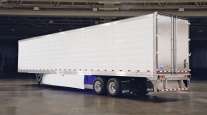Senior Reporter
Trailer Orders Fail to Clear 17,000 in October

[Stay on top of transportation news: Get TTNews in your inbox.]
U.S. trailer orders dropped below 17,000 in October, despite strong demand, to far below a year earlier when orders were the second-most in industry history, ACT Research reported.
October was another month in which not much improved for trailer makers — not the out-of-kilter supply chain prompting shortages or labor constraints, or rising raw materials, or stressed suppliers. The constant was fleets’ ongoing strong, but largely unmet, demand for new equipment.
October’s preliminary net orders were 16,700, according to ACT, which cited trailer makers’ initial data that will be revised shortly. In the 2020 period, orders were 55,175, trailing only September 2018’s all-time high of 57,790, according to ACT.

Maly
“There are so many orders on the order board that the trailer makers are trying to manage things to make sure they don’t get overextended,” Frank Maly, ACT’s director of commercial vehicle transportation analysis, told Transport Topics. “Orders a year ago were part of the COVID quarantine rebound as everybody was coming back online, getting their plans in order.”
In October, trailer makers were able to maintain their production with September’s level, he added, “but they were not able to ramp anything up.”
Take the workforce issue, for instance.
“Labor seems to have stabilized, but is not anywhere close to where it needs to be,” said Craig Bennett, senior vice president of sales for Utility Trailer Manufacturing Co.
Add to that the woeful supply chain.
Labor seems to have stabilized, but is not anywhere close to where it needs to be.
Craig Bennett, senior vice president of sales for Utility Trailer Manufacturing Co.
“It may not stabilize,” Bennett said, “until well into 2022. The offshoring by many suppliers and consolidations are biting us all. Many force majeure orders are still in effect [when unforeseen events prevent suppliers from filling contracts]. The supply chain is very messed up. There is no end in sight, causing delays and inefficiencies and material substitutions.”
Utility has begun taking new orders for next year, adding to ones already pushed into 2022 after being placed this year, he said.
There’s really no way to compare any month or any other time frame to the current situation, said Chris Hammond, executive vice president of sales for Great Dane.

Hammond
“It’s a new world. All of us are dealing with issues in all aspects of providing equipment to the industry,” he said.
“Demand is high, order intake is really a function of when orders are officially placed or accepted,” Hammond added. “We have essentially a committed backlog, but with uncertainties in future build rates and costs we, like others, are managing how we accept orders.”
FTR pegged final net orders at 16,800 and noted trailer orders for the past 12 months total 277,000.
“Some trailer makers that are booking orders beyond the first quarter are utilizing material surcharges in order to price trailers fairly due to commodity prices that are high and volatile,” said Don Ake, FTR vice president of commercial vehicles. “Fleets do want to get their orders scheduled for next year, but that may happen only a month or two at a time.”

Yeagy
Wabash CEO Brent Yeagy said during the company’s latest earnings call private fleet and freight brokers are building trailer pools to ensure consistent access to capacity and more effectively leverage capacity.
“We see the overall freight environment remaining positive through 2022 and well into 2023,” he said. “Coupled with structural changes, in terms of e-commerce-related logistics disruption, the entry of new customers and the emergence of large trailer pools, we see demand remaining robust for an extended period of time, possibly the strongest period of demand we have seen in history.”
The company’s 2022 outlook acknowledges pricing recovery from commodity headwinds experienced this year and includes the expectation for the average selling prices for trailers to increase in the range of $5,000 to $6,000 year-over-year, Wabash Chief Financial Officer Michael Pettit said.
Hyundai Translead Chief Sales Officer Sean Kenney noted, “Hyundai Translead is in a good position relative to manufacturing capacity for next year. It does not have a “tremendous need” to expand its plant employment greatly in 2022 “unless the supply chain were to permit us to increase our overall volumes.”
“We have communicated planned volumes to customers, opened quoting, and are in the process of booking the orders we have promised,” he said.

For Veterans Day, host and Navy veteran Michael Freeze sits down with Army veterans James Rogers, owner of Spartan Direct Trucking Co. and 2020 Transport Topics Trucking's Frontline Hero, and John Baxter, equipment columnist. Hear a snippet above, and get the full program by going to RoadSigns.TTNews.com.
In related news, a U.S. appeals court on Nov. 12 tossed out greenhouse gas emissions rules for heavy-duty truck trailers, ruling two government agencies had exceeded their authority.
“The recent ruling in favor of the Truck Trailer Manufacturers Association lawsuit related to proposed GHG 2 regulations provides the clarity and certainty needed by the entire industry going forward,” Kenney said.
The rule included for the first time fuel-efficiency standards for trailers.
“There was much more complexity to the rule than simply specifying aerodynamic side skirts or automatic tire inflation systems,” Kenney added.
Hammond said he was not surprised at the ruling.
Bennett said he expected other states to mimic California’s own GHG rule to improve trailers’ rolling resistance and aerodynamic performance (enforcement of which is on hold).
That said, “We make a side skirt aero device and also a tail device, and both are being sold,” Bennett added. “The payback is very fast, especially with current fuel prices and an active trucking marketplace.”
Want more news? Listen to today's daily briefing below or go here for more info:





